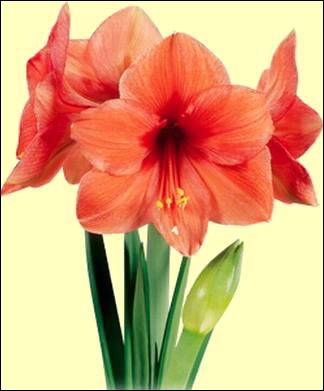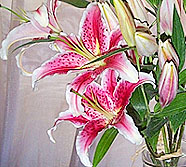

Amaryllis — the ultimate living holiday gift, and the easiest! These stunning blooms are probably the most recognizable flowers seen around the Thanksgiving-through-New Year season. They are given and received by friends, family, and co-workers, and every single year, in many cases! Amaryllis truly are a tradition for millions of people, and it's not difficult to see why.
Of all the flowering bulbs available, Amaryllis are the easiest to bring to bloom. They can be grown indoors and out, although for most of us, it's the flowers that grace our homes during the holiday season that interest us most. Here are some easy-to-follow instructions for planting and caring for your precious Amaryllis:
Indoors — Plant your bulb in a pot that's about 2 inches larger in diameter than the bulb itself. Preferably use a pot that has a hole to ensure proper drainage. They should be planted 4 to 6 weeks before blooms are desired (some Amaryllis take longer to bloom, so always check the planting directions on your particular variety) with one-third of the bulb protruding above the soil. You will want to water well at the time of planting, but then only sparingly until growth begins, when you can gradually start watering more. Place the potted bulb in a warm place with direct light since heat is required for the development of the stems. Ideal temperature is between 68 and 70 degrees F. For continual blooms throughout the holiday season, plant in intervals of 2 weeks.
Outdoors — In zones 7 (with protection) through 10, Amaryllis may be planted outdoors in a well-drained soil in a sheltered, sunny to partly shaded area. Place the bulbs with their tips slightly below the soil. After they've bloomed and the leaves have died away, do not water again until the following autumn.
Now just stand back and be amazed! Amaryllis grow so quickly, you can actually watch their progress! In fact, it's a great thing for your kids to see. Growing an Amaryllis is like a quick and beautiful science lesson. I recommend once your bulbs have started to grow, give the kids a ruler and let them record the growth every day. It's also fun to set up a little competition — plant several and see whose grows the fastest and whose blooms first! And the end result will be a parade of brilliant color to decorate your holiday celebrations!
Another great thing about Amaryllis is that you can put the bulbs up after they're done blooming, and they'll stay dormant until next fall when you need another boost of blazing color to warm those cold days! Clean the bulbs and store them on their sides in a cool, dry, dark place, such as the crisper of your refrigerator for a minimum of 6 weeks. Be sure you do not store your Amaryllis bulbs with apples, as this will sterilize the bulbs. After 6 weeks any can take the bulbs out whenever you want to plant them!
What better way to teach your kids about nature, the cycle of life, and the joy of self-sufficiency, than through gardening? There's something wonderfully satisfying about playing in the dirt and getting completely grubby on a perfect spring morning! Or most any morning, for that matter! And your kids instinctively know this joy. Put a white shirt and a clean pair of pants on them, and the only thing they want to do is go dig holes in the backyard! Right?
So why not cultivate that desire to get dirty and put some kid-sized gardening tools and some seeds in their hands? They'll have fun while learning about germination. The hands-on science lessons they'll be learning will never be forgotten, as they see first-hand the importance of the sun and water on growing a living thing. And once the veggies or flowers are grown, they'll be so proud of themselves! They did something important and valuable. You'll have created a gardener for life. And one thing you can say about a gardener is they'll always be able to provide for themselves. And can you think of a better way to teach your kids about eating healthy food than showing them how to grow their own? They'll learn the value of hard work, they'll eat better, for the rest of their lives, and they'll remain active. Once you get the gardening bug, it never lets you go! So, get those kids out there and let 'em get dirty!
Visit our Park Seed Memories to see some of our own workers and customers as their kids, or they themselves as little ones, learned the joy of playing in the dirt!
General Aspects
The Amaryllis (Hippeastrum) is a true bulb that originated in the tropical areas of South America. Thus, it is a tender bulb. It performs best when grown under warm (20 to 25 o) temperatures for 9 to 10 months to promote flowering and vegetative growth, followed by 2 to 3 months of either cool (15-20 o C) dry storage or cool (15-20 oC) growing conditions. The use of one of the latter conditions is required to promote reflowering of the bulb.
Most marketed bulbs sold are greater than 8 inches (20 cm) in circumference, and are either Dutch, Israeli, or South African-grown. They produce 2 to 6 flowers per floral stalk, with the average being 4. Very large bulbs normally produce 2 flower stalks. Flower colors are red, white, pink, orange, salmon, and bicolored (mostly whites with pink or red flushes). Plant heights range from 18 to 36 inches depending on the cultivar, the country in which the bulb was produced, and home forcing conditions.
Indoor Growing of New or Replanted Bulbs
Planting --Plant in a well-drained, pH 6 to 6.5, sterilized potting medium. Do not use a medium that contains pine bark! An equal mixture of peat and perlite is excellent. Use a standard-depth (6-inch diameter) pot that has adequate drainage holes. Carefully plant the bulb, with 1/3 being above the rim of the pot.
Watering -- After planting, thoroughly wet the medium with lukewarm water. Then keep it moist, but not wet. Don't over-water! Initially, once per week is usually adequate. Avoid watering over the bulb nose.
Temperatures -- Initially grow at 20to25 o C until bulb begins to root and the leaves and floral stalk(s) begin to grow. Afterwards, any temperature from 15 to 25 oC can be used. When in flower, the coolest area in the home is best.
SunLight -- In the home, the plant should be kept in a ell-lighted area. A southern exposure is best. When plant is flowering, keep it out of direct sunlight. This helps to promote a longer flower life.
Fertilization -- After the plant begins to grow, fertilization is essential. Use either a complete nitrogen, phosphorous, potassium (NPK) slow- release fertilizer that lasts several months or a liquid (NPK) fertilizer, 2 to 4 times per month.
Flower Removal -- As the flowers fade, carefully cut them off.
Flowering Stalk Removal -- After all flowers fade, carefully cut the floral stalk off just above the bulb nose. Take care that the water that normally runs out of the freshly cut stalk does not run onto furniture, etc.
Outdoor Growing Conditions
Amaryllis (Hippeastrum) can be grown outside in Climatic Zones 8 to 10. In other climatic zones, the plants can be placed outside after the danger of frost has passed. Plunge the entire pot in the garden bed and fertilize the bulb 2 to 3 times per month. Avoid placing the bulb where it will dry out excessively. In cooler climatic zones, the plants must be brought indoors in September.
Reflowering of the Bulb
If the bulb has retained its original bulb size or if it has gained in size, it can be reflowered. The key is to place the bulb at a temperature of 55 oF for a minimum of 8 to 10 weeks. This can be accomplished either by withholding water and then placing the bulb in a cool storage area or, preferably, by placing the plant in a cool (15 o C growing location for this length of time. It is not necessary for the plant to go dormant! Once the plant has received 8 to 10 weeks of 15° C, follow the growing instructions described above.
Dividing Older Bulbs
If the bulbs have been grown for 2 or more years, most cultivars will produce offset (daughter) bulblets. Homeowners can handle these bulbs in one of two ways. First, the bulbs can be transferred to a larger pot with the bulblets left attached. By doing this, a large number of flowering bulbs will ultimately be growing in a single pot. This creates quite a show. Alternatively, the bulblets can be carefully removed from the mother bulb and each of them planted in individual pots. Normally, this takes place after the bulbs have been stored dry for 8 to 10 weeks as described above.
Diseases and Insects
Normally, when healthy bulbs are purchased, few diseases or insects are encountered. The major potential disease is Stagonospora (Fire or Red Spot). The insects that can become a problem are: mites, thrips, and mealybugs.
Control:
For Stagonospora spray 50 gm Iron Sulphate and 60 gm Oxy Copper Chloride in 1 liter water, separately with a two days gap.
For mites, thrips and mealybugs, spray the plants with 20 ml of Endo in 1 liter of water. This can be followed with 20 ml CPP in I liter water after a week if the attack continues.